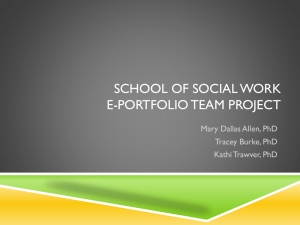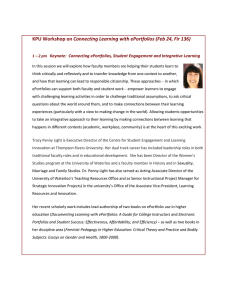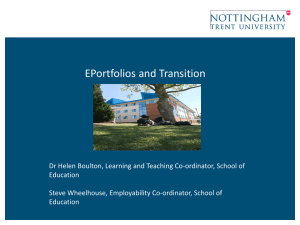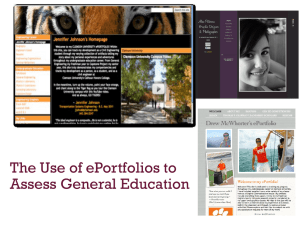Special Issue: ePortfolios • Special Issue
advertisement
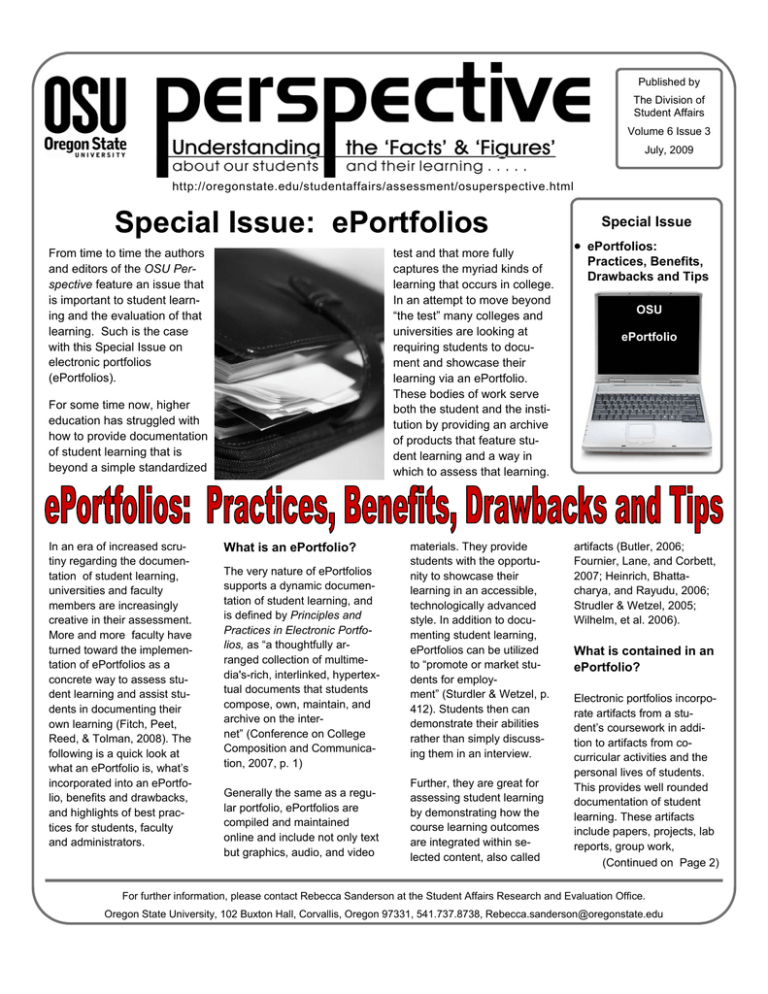
Published by The Division of Student Affairs Volume 6 Issue 3 July, 2009 http://oregonstate.edu/studentaffairs/assessment/osuperspective.html Special Issue: ePortfolios From time to time the authors and editors of the OSU Perspective feature an issue that is important to student learning and the evaluation of that learning. Such is the case with this Special Issue on electronic portfolios (ePortfolios). test and that more fully captures the myriad kinds of learning that occurs in college. In an attempt to move beyond “the test” many colleges and universities are looking at requiring students to document and showcase their learning via an ePortfolio. These bodies of work serve both the student and the institution by providing an archive of products that feature student learning and a way in which to assess that learning. For some time now, higher education has struggled with how to provide documentation of student learning that is beyond a simple standardized In an era of increased scrutiny regarding the documentation of student learning, universities and faculty members are increasingly creative in their assessment. More and more faculty have turned toward the implementation of ePortfolios as a concrete way to assess student learning and assist students in documenting their own learning (Fitch, Peet, Reed, & Tolman, 2008). The following is a quick look at what an ePortfolio is, what’s incorporated into an ePortfolio, benefits and drawbacks, and highlights of best practices for students, faculty and administrators. What is an ePortfolio? The very nature of ePortfolios supports a dynamic documentation of student learning, and is defined by Principles and Practices in Electronic Portfolios, as “a thoughtfully arranged collection of multimedia's-rich, interlinked, hypertextual documents that students compose, own, maintain, and archive on the internet” (Conference on College Composition and Communication, 2007, p. 1) Generally the same as a regular portfolio, ePortfolios are compiled and maintained online and include not only text but graphics, audio, and video materials. They provide students with the opportunity to showcase their learning in an accessible, technologically advanced style. In addition to documenting student learning, ePortfolios can be utilized to “promote or market students for employment” (Sturdler & Wetzel, p. 412). Students then can demonstrate their abilities rather than simply discussing them in an interview. Further, they are great for assessing student learning by demonstrating how the course learning outcomes are integrated within selected content, also called Special Issue • ePortfolios: Practices, Benefits, Drawbacks and Tips OSU ePortfolio artifacts (Butler, 2006; Fournier, Lane, and Corbett, 2007; Heinrich, Bhattacharya, and Rayudu, 2006; Strudler & Wetzel, 2005; Wilhelm, et al. 2006). What is contained in an ePortfolio? Electronic portfolios incorporate artifacts from a student’s coursework in addition to artifacts from cocurricular activities and the personal lives of students. This provides well rounded documentation of student learning. These artifacts include papers, projects, lab reports, group work, (Continued on Page 2) For further information, please contact Rebecca Sanderson at the Student Affairs Research and Evaluation Office. Oregon State University, 102 Buxton Hall, Corvallis, Oregon 97331, 541.737.8738, Rebecca.sanderson@oregonstate.edu Page 2 ePortfolios (Continued from Page 1) majority of the cost put out in the start up; experiments, exams, internship papers, co-curricular materials and other documents, including personal artifacts, that student’s believe demonstrate their learning and capabilities (LaGuardia Community College; Heinrich, 2007; Penn State ePortfolios, 2008). Besides documentation of student works, ePortfolios are designed as an opportunity to reflect on the artifacts displayed within the ePortfolio. The use of reflection links student learning in courses with direct application outside the classroom and demonstrates the learning taking place in both arenas. Further, the reflection process of ePortfolios allows for a cross-curricular understanding of the materials, highlighting the ways different course content interconnects and facilitates a deeper understanding of the subject areas (Heinrich, 2007). Many other elements are incorporated into an ePortfolio. Below is a short list highlighting the contents of an ePortfolio: (list taken from LaGuardia Community College; Heinrich, 2007; Penn State ePortfolios, 2008). • • • • • • • • • • Welcome (a brief statement) About Me (a biography) Mission and Vision Classes and Projects (selected coursework, in-progress/completed) Educational Goals (a reflection on your educational and career goals) Resume/CV (an electronic version of your resume/CV which can be interactive with hyperlinks) • • What are the benefits and drawbacks of ePortfolios? • ePortfolios: • • • • • • • Professional Experience Reflections and Self-evaluations (an explanation why a piece was chosen and the learning process) • • Links (annotated web sites you suggest to your visitors) • Contact Information • • assist with multimedia technological, problem solving and communication skills, as well as general literacy; provide concrete evidence of learning; allow for the “exchange of ideas and feedback” (p.11); provide opportunities for reflection; • • • • • • increase “sense of pride” for those creating the ePortfolio (p. 11); actively engage in continuous assessment of their work; provide an opportunity to integrate a dynamic presentation of artifacts from text, audio, graphic and video; • are easy to update and maintain; • are portable and accessible to a large audience; • provide for easy organization and quick searches due to being online; • are easily stored; are economically sound, with the have the ability to be set with varying degrees of privacy. Although there are a number of benefits, there are also a number of drawbacks that must be managed when utilizing ePortfolios as a tool to track and assess student learning. Below is a short list of the issues Butler (2006) found when doing his research which were also supported by Wilhelm (2006): There are a number of benefits to implementing ePortfolios as a way to track student learning and to assess course and institutional outcomes. Many of these benefits are interrelated and support each other. Below is a list of benefits presented by Butler (2006) in his article, A Review of the Literature on Portfolios and Electronic Portfolios. • “have the potential to be standardized across regions and countries” (p. 12); Difficulty authenticating the evidence presented Technological knowledge and skills needed to create ePortfolios Possibility that students will be assessed on their technical skills rather than content and reflection Difficulty in “judging quantity and quality of evidence” (Butler, 2006, p. 12) “Courses may need restructuring” to support the use of ePortfolios (Butler, 2006, p. 12) Space and time to address issues regarding rigorous reflection Buy-in of student, faculty and administration essential for ePortfolios to be effective Institutional issues include: space to manage data defining access to the ePortfolios security and privacy “copyright and intellectual property concerns (Butler, 2006, p. 13) Software to be flexible with the skill levels of the users Significant amount of time and effort that goes into creating an ePortfolio Upgrades to equipment and software Possibility of software and technical problems (Continued on Page 3) For further information, please contact Rebecca Sanderson at the Student Affairs Research and Evaluation Office. Oregon State University, 102 Buxton Hall, Corvallis, Oregon 97331, 541.737.8738, rebecca.sanderson@oregonstate.edu Page 3 ePortfolios (Continued from Page 2) “disadvantages of students allowing public access to their documents” ((Butler, 2006, p. 3) What are the best practices for supporting students? In order for ePortfolios to be successful, students need to be the drivers behind the content and creation of them (Butler, 2006; Fournier, Lane and Corbett 2007; Heinrich, Bhattacharya and Rayudu 2006; Strudler and Wetzel 2005; Western Association of Schools and Colleges, 2008). This fosters buy-in and engagement with the process of creating an ePortfolio that effectively highlights students learning. In addition, students need specific supports in place in order for the creation of ePortfolios to be successful. • • • Discussions of issues regarding student representation of self in “online resumes, profiles, etc.” (Butler, 2006, p. 3) • • • • • • • • • Clear written instructions that describe the purpose and meaning of ePortfolios Emphasis on the importance of highlighting the student’s cultural background Clear descriptions of finished product Sharing rubrics that will be used in assessing the quality of ePortfolios • • • • • Assistance with the ePortfolio design Explicit examples of the benefits of ePortfolios, e.g. development of student learning, possible employment opportunities • Assistance with utilizing features of web-design, highlighting user-friendly webpage design and functionality • Discussions of “protocols for obtaining permission and documenting Internet sources” (Butler, 2006, p. 2) Discussions of critical issues regarding the advantages and • • Clear descriptions of learning outcomes Clear descriptions of content criteria for ePortfolios • Acquaintance with how students “construct professional ethos in their own ePortfolios” (Butler, 2006, p. 3) Below is a list of best practices regarding supporting students in the creation and up keep of ePortfolios (List adapted from Butler, 2006; Fournier, Lane and Corbett, 2007; Heinrich, Bhattacharya and Rayudu, 2006; Strudler and Wetzel, 2005; Western Association of Schools and Colleges, 2008). • • • Encouragement for students to utilize OSU resources, such as the Center for Writing and Learning and computer help desk, which will assist with more effective content and ePortfolio function Regular collaboration “with other faculty, technical staff, and program directors to share the most effective ways to provide feedback and teach reflection” (Butler, 2006, p. 4) Encouragement to students to link content to earlier content drafts which will demonstrate their learning outcomes Encouragement for students to link content across various courses Familiarity with “relevant theory and ePortfolio research” (Butler, 2006, p. 5) “Practice in ongoing programmatic assessment of student ePortfolios” (Butler, 2006, p. 5) Assistance in identifying readers who will assess the student’s ePortfolio and encourage students to become familiar with the expectations of different readers Discussion of ways in which students can revise their ePortfolios for different readers Clear information about the “various stages of drafting and web -design” (Butler, 2006, p. 14) Emphasis on the importance of ongoing, thoughtful reflection as being pivotal in the creation of dynamic ePortfolios Opportunities for peer review and feedback on ePortfolio content Clear and constructive feedback which will enable students to have an opportunity to revise their content and offer technical tips for improvement • • • • Use of findings of ePortfolios assessment to improve approaches to teaching Ongoing, drop-in workshops and studios to support the technological needs of the students Introduction of ePortfolios early on in the course Discussions focusing on the availability of cross-curricular opportunities for collaboration Continued on Page 4 For further information, please contact Rebecca Sanderson at the Student Affairs Research and Evaluation Office. Oregon State University, 102 Buxton Hall, Corvallis, Oregon 97331, 541.737.8738, Rebecca.sanderson@oregonstate.edu Page 4 References OSU Perspective: What is it? The OSU Perspective was developed to provide assessment and other information about our students and programs. We hope that by making this information available to OSU faculty and staff, we can stimulate conversation that helps keep students and student learning at our core. The Perspective is published both in print and on the web: http:// oregonstate.edu/studentaffairs/ assessment/osuperspective.html. Please contact Rebecca Sanderson, Ph.D., Student Affairs Research and Evaluation Office, 102 Buxton Hall, 541-737-8738, or email: rebecca.sanderson@oregonstate.edu. Masthead designed by Judy Burks, OSU. Editing assistance conducted by Jodi Nelson, OSU. ePortfolios (Continued from Page 3) The move to utilizing ePortfolios as a way to document student learning is becoming common among many universities. In order to ensure a successful transition to ePortfolios as documentation of student learning and an assessment tool, there are a number of practices that create an environment for success. Creating this environment allows students, administrators and faculty the opportunity to make the most of the benefits of ePortfolios while minimizing the drawbacks. Brown, Judith O. (2002). Know thyself: The impact of portfolio development on adult learning. Adult Education Quarterly, 52(3), 302-315. Butler, Philippa. (2006). A Review of the Literature on Portfolios and Electronic Portfolios. http://eduforge.org/ docman/view.php/176/1111/ ePortfolio%20Project%20Research% 20Report.pdf . Challis, Di. (2005). Towards the Mature ePortfolio: Some Implications for Higher Education. Canadian Journal of Learning and Technology, 31(3), from http://www.cjlt.ca/index.php/cjlt/ article/view/93/87. Fitch, Dale, Melissa Peet, Beth Glover Reed, Richard Tolman. (2008). Journal of Social Work Education, 44(3), 37-54. Fournier, J., Lane, C. & Corbett, S. (2007). The Journey to Best Practices: Results of a Two-Year Study of ePortfolio Implementation in Beginning Composition Courses. In C. Montgomerie & J. Seale (Eds.), Proceedings of World Conference on Educational Multimedia, Hypermedia and Telecommunications 2007 (pp. 20082016). Heinrich, E., M. Bhattacharya, and R. Rayudo. (2007). Preparation for Lifelong Learning Using ePortfolios. European Journal of Engineering Education, 32 (6), 653-663. http:// catalyst.washington.edu/ research_development/papers/2007/ EdmediafournierlanecorbettFINAL.pdf. Hauge, Trond E. (2006). Portfolios and ICT as means of professional learning in teacher education. Studies in Educational Evaluation, 32(1), 23-36. Hawkins, Carol Lee, and Sharon Black. (2004). Developing Electronic Portfolios Across the State of Utah: Breaks, Breakdowns and Breakthroughs. Computers in the Schools, 21(1-2), 95-113. Heinrich, E., M. Bhattacharya and R. Rayudu. 2007. Preparation for Lifelong Learning Using ePortfolios. European Journal of Engineering Education, 32(6), p. 653-663. IMS ePortfolio Best Practice and Implementation Guide. (2005). IMS Global Learning Consortium. Retrieved May 10 2009, from http:// www.imsglobal.org/ep/epv1p0/ imsep_bestv1p0.html. LaGuardia Community College. (NA). Develop your ePortfolio. Retrieved June 5 2009, from http:// www.eportfolio.lagcc.cuny.edu/ develop.html. Pennsylvania State University. (2008). ePortfolio Collect. Retrieved June 15th 2009, from http:// portfolio.psu.edu/collect. Principles and Practices in Electronic Portfolios. (2007). Conference on College Composition and Communication. Retrieved May 10 2009, from http://www.ncte.org/cccc/resources/ positions/electronicportfolios. Strudler, Neal., Keith Wetzel. (2005). The Diffusion of Electronic Portfolios In Teacher Education: Issues Of Initiation and Implementation. Journal of Research on Technology in Education, 37(4), 411-433. Western Association of Schools and Colleges. (2008). Rubric for Assessing the Use of Portfolios for Assessing Program Learning Outcomes. Retrieved May 15 2009 from http:// www.wascsenior.org/findit/files/ forms/PortfolioRubric4_08.pdf. Wilhelm, Lance. Kathleen Puckett, Sally Beisser, William Wishart, Eunice Merideth, and Thilla Sivakumaran. (2006). Lessons Learned from the Implementation of Electronic Portfolios at Three Universities. TechTrends, 50(4), 62-71. The previous article was researched, written and developed by Angi Baxter, Graduate Assistant in Student Affairs Research and Evaluation. For further information, please contact Rebecca Sanderson at the Student Affairs Research and Evaluation Office. Oregon State University, 102 Buxton Hall, Corvallis, Oregon 97331, 541.737.8738, rebecca.sanderson@oregonstate.edu
